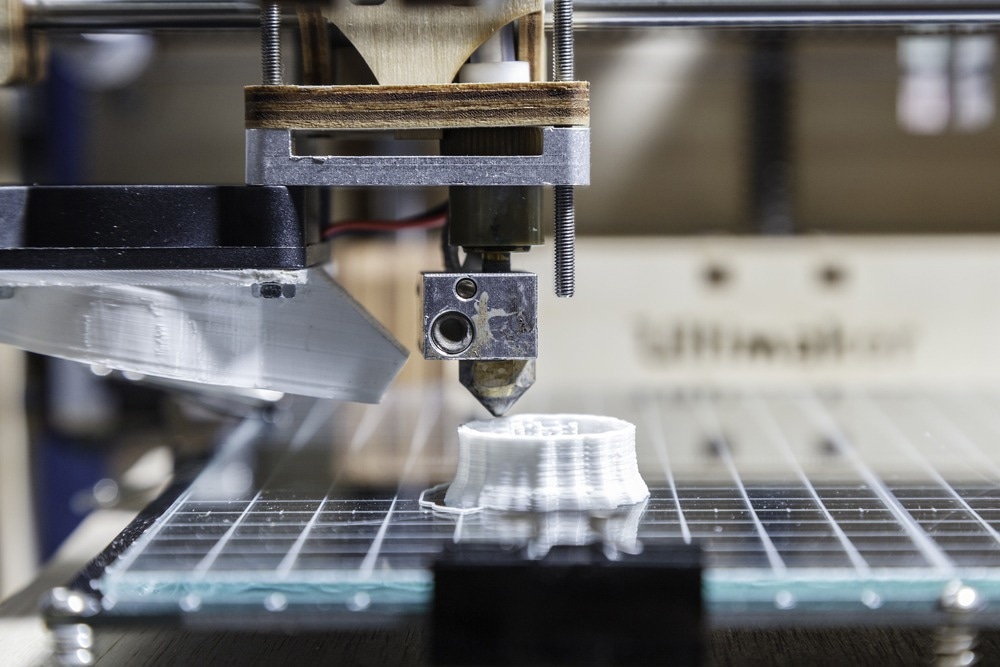Scientists from Finland and Denmark have demonstrated the 3D printing of thermally conductive plastic filaments which have potential applications as passive heat sinks for electronic devices. Their research has appeared in the journal Additive Manufacturing.

Study: Material extrusion additive manufacturing and experimental testing of topology-optimised passive heat sinks using a thermally-conductive plastic filament. Image Credit: Sergi Lopez Roig/Shutterstock.com
The Need for Cooling in Advanced Electronics
The development of innovative advanced electronics for applications such as wearable devices, battery-powered devices, and aerospace applications is a cutting-edge field. A key requirement of these applications is the need for effective and reliable cooling to avoid safety and performance issues.
Cooling systems require their components to possess several characteristics, such as low cost, ease of use, resistance to chemicals and corrosion, and a lack of electrical conductivity. Plastics have emerged as suitable materials for cooling systems. These materials perform better than metals, which carry the risk of short circuits and fires, requiring them to be electrically grounded.
Heat sinks transfer thermal energy from the system to another medium, typically a surrounding fluid flow such as air or water. However, these systems can suffer from electromagnetic interference due to their shape, which is a key problem hindering their use in the telecommunications and aerospace industries.
Plastic Heat Sinks and Additive Manufacturing
The advantage of using plastic materials for heat sinks is their lack of electrical conductivity and high thermal conductivity. Recognizing this advantage, recent studies have investigated the development of polymer-based materials for use in heat sinks and cooling systems for electronics devices in multiple industries.
Conventional plastics manufacture is extremely environmentally damaging, however. Traditional manufacturing approaches suffer from a lack of design freedom, prohibitive cost, carbon emissions, and generation of significant amounts of waste materials.
Additive manufacturing has several benefits over traditional material manufacturing methods which make it suitable for use in a wide range of industries, from commercial products to biomedical science, the aerospace industry, automobile industry, and construction. Additive manufacturing, also known as 3D printing, covers a wide range of techniques, such as material extrusion and light-assisted methods.
3D printing methods can produce functional device components with complex architectures due to their enhanced design freedom. By depositing materials layer by layer, 3D printing techniques produce significantly lower amounts of waste at a smaller cost compared to conventional manufacturing methods. Additionally, multi-material printing has several possibilities for innovative device and component manufacture.
Recent studies have demonstrated the suitability of additive manufacturing methods for producing elaborate plastic components with complex architectures for use in electronics cooling systems. The development of thermally conductive plastics using 3D printing methods has been reviewed extensively in recent years, providing possibilities for the future of advanced cooling systems for multiple industries.
The Study
The new paper has focused on the development of 3D-printed thermally conductive plastic filaments for novel heat sink cooling systems. Filament topology has been explored to produce high-performance passive heat sinks which exploit natural convection.
Test printing, SEM imagining, and thermal conductivity testing were employed to evaluate the filament’s thermal performance, a key parameter in cooling systems. Material extrusion was selected as the 3D printing technique in the study, and soluble support materials were used during manufacture. The resulting filaments possess a complex, optimized structural design.
Heat sinks were designed with the specific filament and process in mind, and anisotropic thermal conductivity was included in the optimization process. The study demonstrated the suitability of topology optimization to improve 3D printed passive heat sink performance.
Research Findings
The optimized samples produced in the research display enhanced thermal performance, thus making them suitable for passive heat sink systems. The best designs produced using topology optimization possess 10% and 20% lower thermal resistance in vertical and horizontal directions, respectively. The designs performed better than reference straight-fin heat sinks.
Measuring the material’s thermal conductivity values under anisotropic and isotropic assumptions helped to achieve the enhanced thermal performance observed in the research findings. An anisotropic thermal conductivity model optimized the heat sink’s thermal performance in the vertical direction.
On the contrary, in the horizontal direction, significant base plate distortion was caused by the anisotropic property-based design optimization method. A consequent, significant air gap between the heat source and base plate occurs due to distortion, which impairs heat transfer in the system. This severely impacts the potential cooling performance of the novel heat sink presented in the paper.
In conclusion, the study has demonstrated the suitability of additive manufacturing for producing novel plastic filament-based heat sink components for advanced electronics applications. The material extrusion process can be fully controlled. However, there are some critical challenges that need to be addressed in future research, and whilst satisfactory results were achieved with the printing parameters, these can be improved further by taking into account thermal performance.
More from AZoM: The Use of AI in Chemical Processes
Further Reading
Huttunan, E et al. (2022) Material extrusion additive manufacturing and experimental testing of topology-optimised passive heat sinks using a thermally-conductive plastic filament Additive Manufacturing 103123 [online, pre-proof] sciencedirect.com. Available at: https://www.sciencedirect.com/science/article/pii/S2214860422005127?via%3Dihub
Disclaimer: The views expressed here are those of the author expressed in their private capacity and do not necessarily represent the views of AZoM.com Limited T/A AZoNetwork the owner and operator of this website. This disclaimer forms part of the Terms and conditions of use of this website.